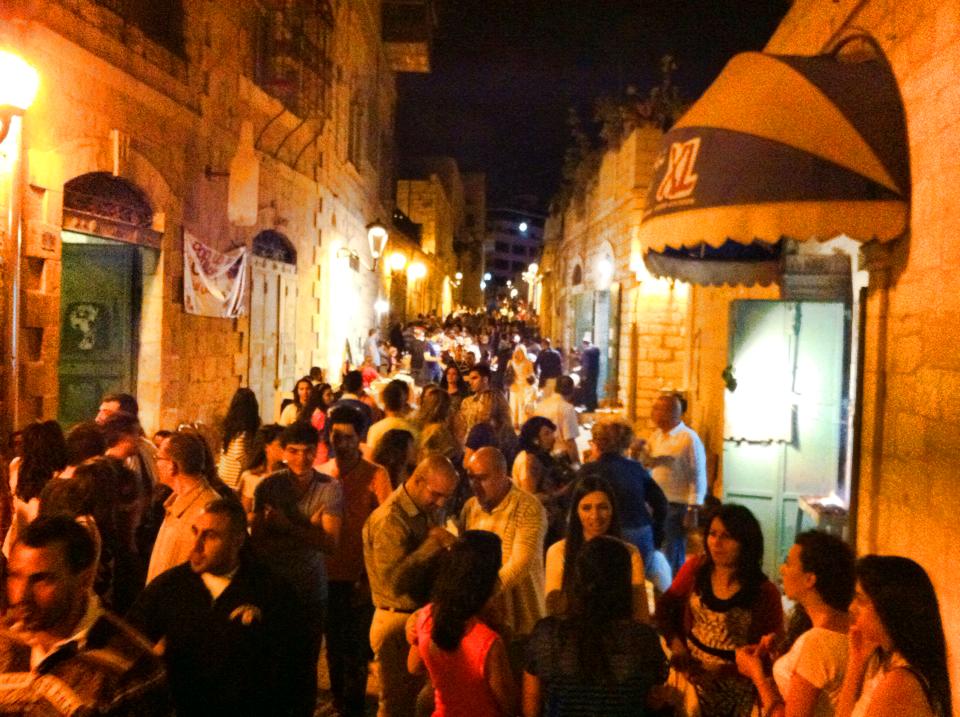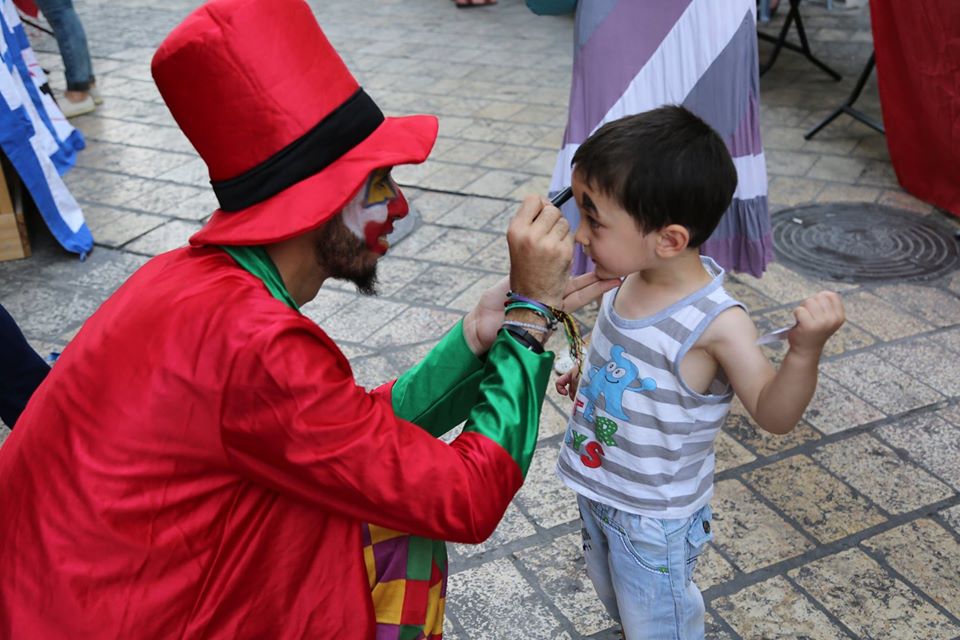Originally published on Ma’an News Agency on December 3, 2014.

BETHLEHEM (Ma’an) — The Bethlehem of today is a far cry from the little village of Jesus’ era, and the historic core of this West Bank hub has long since been superseded by the busy modern commercial areas around it.
But come Christmastime all attention returns to the city center, particularly given the area’s 2012 inclusion on the UNESCO World Heritage List, and the memory of the moment 2,014 years ago when Jesus Christ is said to have been born in a Bethlehem manger takes center stage.
This year, organizers are planning for one of the busiest seasons in memory, hoping to entice Palestinians from Bethlehem, across the West Bank, and inside Israel as well as visitors from around the world to spend the holidays in the holy city.
“This year we engage in the traditions of preparing for Christmas that have been the same for the last 2,000 years,” Issam Juha, one of the main organizers of the festivities and the deputy head of Bethlehem’s Center for Cultural Heritage Preservation, told Ma’an during an interview at the Bethlehem Municipality.
“Nevertheless, each year has its special aspect. … In our celebration this year we are trying to spread the celebration throughout all of Star Street, the Nativity Church, and Manger Square.”
Christmas festivities focus almost entirely on Manger Square, the obvious focal point given the presence of Jesus Christ’s traditional birthplace at the site of the Nativity Church on the square’s eastern side.
But in the past locals have complained that such a focus bypasses the city of Bethlehem itself, as the historic pilgrimage route along Star Street remains empty most of the time as visitors crowd the square for performances before heading to restaurants, bars, and clubs elsewhere.
Juha told Ma’an that organizers were working to ensure a more even distribution of festivities across the Old City, making the festival more accessible to locals and allowing visitors to become better acquainted with the city as a whole.
Juha said that the festivities that begin following the Dec. 6 tree-lighting ceremony in Manger Square will be spread across five different venues — Manger Square, Star Street, the Nativity Church, the Catholic Action Center, and the Terra Sancta School — with religious and spiritual performances concentrated in Manger Square and cultural performances and Christmas markets taking place elsewhere.
With an expected 100,000 tourists visiting Bethlehem during December alone, the dispersal of festivities across the Old City could have major benefits for local merchants.
“We are trying to increase the number of tourists who prolong their stay in Bethlehem, spending more hours wandering in the streets and getting to know more about its culture, its people, its traditions, its heritage, and its architecture,” he told Ma’an.
“By having more events on Star Street, more visitors will learn about our historic town and know that Bethlehem is more than just the Church of Nativity.”
A central complaint of both locals and workers in the tourism industry is that the vast majority of those who visit Bethlehem arrive as a part of Israeli tour groups, which generally limit visitors’ access to the city and instead show them the Church of the Nativity for an hour or two before returning to Jerusalem immediately after.
Israel’s control over the Holy Land tourism industry and its restrictions on the use of Palestinian tour guides by foreign tourists not only hinders local economic growth, it also treats Bethlehem as a museum city of Christian monuments with no connection to modern Palestinian life and society.

‘Bethlehem, city of peace’
Elias Deis, however, is committed to changing that. A project director at Holy Land Trust, Deis is one of the main organizers of the night-time Christmas market that will grace Star Street from Dec. 21-24.
“Star Street and Bethlehem are always full of visitors during Christmas time, especially on the 24th of December” during the Christmas Eve parade from Jerusalem, he told Ma’an during an interview at his office on Star Street with a view toward Jerusalem.
“But on Star Street the stores are always closed.”
“The market is an opportunity for the local residents to sell their crafts and food and get people to stay around here, instead of tourists going to (Manger) Square or outside of Bethlehem.”
“Our primary goal is to revive Star Street, open the stores, and bring economic movement back to the street.”The Star Street Christmas market will see the opening of about 20 outlets staffed by locals — half normally-closed storefronts and half booths — along the historic street from 4-8 p.m. until Christmas Eve, when the bazaar will be open from 9 a.m. until 2 p.m.
The market will also have musical stages, clowns, children’s activities, and more, all in an effort to get local families into the Christmas spirit and put them at the center of the year’s festivities.
For Deis, reviving the street at Christmastime ties into wider efforts to emphasize and reflect upon the model of religious coexistence Bethlehem offers the world.
“During the month, we will also have workshops and lectures about the meaning of Christmas for Bethlehem with both Christian and Muslim leaders. … We are trying to ask: How can we get society more involved in the spiritual meaning of Christmas? What is the responsibility of Bethlehemites in holding this message of peace?”
“Bethlehem is an open, multicultural, and multi-faith city, this is our vision and this is our message,” he told Ma’an.
“The Christmas market will be a small model for all of society. Christians, Muslims and Jews are all welcome to come to celebrate Christmas in Bethlehem, the city of peace.”
Deis highlighted that the Bethlehem area — which has a mixed population that is about half-Christian and half-Muslim, and is surrounded by both Christian and Muslim villages — is a model of religious harmony for the world, and he hopes that activities like the Christmas market and the workshops can help “create spaces for everyone to come together, share, and talk.”
His hopes contrast sharply with the the increasingly pessimistic mood in the region. From Deis’ office, the Jewish-only settlement of Har Homa looms large over the horizon, towering over residents powerless to stop its expansion.
Established on lands that once hosted a large forest but was confiscated from Palestinians, including members of Deis’ own family, the settlement is a constant visual reminder for Bethlehemites of the Israeli occupation’s presence and control over their lives.
In the past, bloody Israeli assaults on Gaza and attacks on the West Bank have interfered with festivities in the city, even halting many Christmas activities in 2008.
Despite the pressure, however, Christmas organizers are insistent that going ahead with the celebration in light of the occupation is the best path of resistance.
“Christmas is Christmas,” Issam Juha told Ma’an. “In this land we are used to suffering, to experiencing hard times, siege, escalations, violations of our rights, as well as our legal authority on this land.”
“But we have always maintained our hope for a better future, for a better life for our children, and for getting our freedom.” He added: “No one is able to prevent us from celebrating Christmas, whatever the circumstances. … It is time now to celebrate Christmas in justice, to celebrate Christmas in peace.”
